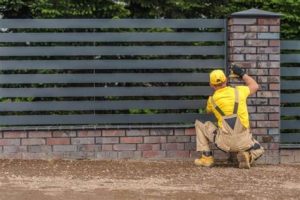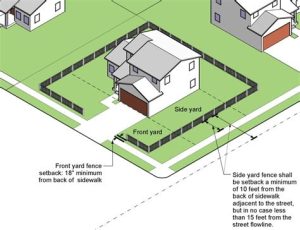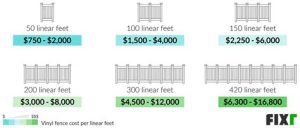Learn about local regulations, the importance of permits, the application process, and the costs of not obtaining a permit for your project.When it comes to enhancing your property with a fence, many homeowners are quickly swayed by misconceptions surrounding fence installation permits. The world of local regulations can be intimidating, leading to a host of misunderstandings that deter people from moving forward with their fencing projects. However, it’s essential to dispel these myths and understand the importance of obtaining the necessary permits. Not only can permits help you avoid legal complications, but they can also ensure that your fence complies with local standards. In this blog post, we will explore the nuances of fence installation permits, clarify the application process, and highlight the potential costs associated with ignoring these vital regulations. Let’s unravel the truth behind fence installation permits and empower you to make informed decisions for your property.
Understanding local regulations
When it comes to installing a fence, understanding local regulations is crucial. These regulations can vary significantly from one area to another, affecting everything from the type of materials you can use to the height and placement of your fence. Failing to comply with these regulations can lead to serious consequences, including fines and having to dismantle your fence.
Before you embark on your fence installation journey, it’s essential to check with your local government or neighborhood association to gather information about any existing fence codes. Many regions require homeowners to obtain a building permit prior to erecting a fence. This is often to ensure safety standards are met and to maintain the aesthetic harmony of the neighborhood. Rules may dictate specific heights for front and side yard fences, or even restrict the use of certain materials.
Consulting with local authorities may seem daunting, but it is a necessary step. Consider creating a checklist that includes where to check for local regulations, key guidelines, and contacts for local inspectors. Knowledge is power, and understanding these regulations will help you avoid the pitfalls associated with improper fence installation.
Dispelling misunderstandings about permits
When it comes to fence installation, many homeowners harbor misconceptions about the need for permits. One of the most common misunderstandings is that permits are only necessary for extensive projects. In reality, even minor installations can require a permit, depending on local regulations.
Another widespread myth is that obtaining a permit is an arduous and time-consuming process. In truth, the permit application process can often be straightforward if you have the necessary documentation and follow local guidelines. Understanding the requirements in your area can save you time and trouble.
Lastly, many people believe that skipping the permit can save them money. However, not obtaining a required permit can lead to hefty fines and even the need to remove the fence.
Importance of obtaining a permit
Obtaining a permit for your fence installation is not just a bureaucratic hurdle; it’s a crucial step that ensures your project aligns with local regulations and enhances the safety and aesthetics of your property. Many homeowners overlook the significance of this process, often dismissing it as an unnecessary formality. However, there are several key reasons to prioritize obtaining a permit.
First and foremost, acquiring a permit helps you avoid potential legal issues. Building codes exist to ensure that structures are safe and properly constructed. By securing a permit, you demonstrate your commitment to adhering to these regulations, minimizing the risk of fines or legal action down the line. Additionally, it protects you from conflicts with neighbors and long-term property disputes.
Secondly, a permit can significantly enhance the value of your property. Potential buyers often seek homes that have been renovated or improved with proper documentation. Having a permit for your fence installation shows prospective buyers that the work was done professionally and in compliance with local standards, making your property more attractive in the real estate market.
| Reasons to Obtain a Permit | Benefits |
|---|---|
| Legal Compliance | Avoid fines and legal issues |
| Property Value | Increases appeal for potential buyers |
| Safety Assurance | Reduces risk of accidents or damage |
Permit application process explained
Understanding the permit application process is crucial for anyone looking to install a fence on their property. The process can vary depending on your location, but there are several common steps that most homeowners can expect to follow.
The first step in the permit application process involves checking local building codes and regulations. Many municipalities have specific requirements regarding fence height, material, and placement. To ensure compliance, you should contact your local zoning office or visit their website for detailed guidelines.
Once you have a clear understanding of the regulations, the next step is to gather the necessary documentation for your application. This often includes a detailed site plan that shows the proposed location of the fence, along with measurements and materials intended to be used. Make sure to supply any additional information that your local authority may require.
After compiling your documents, you will submit them along with an application form and any applicable fees. Depending on the complexity of your project, the review process can take anywhere from a few days to several weeks. Be prepared for potential consultations with local officials to clarify aspects of your application.
Finally, once your permit is approved, you will receive a notification granting you the authority to commence your fence installation. Remember, it is essential to display your permit on-site as required, ensuring that you remain compliant with all local regulations throughout the installation process.
Costs and implications of not getting a permit
When it comes to fence installation, many homeowners underestimate the importance of obtaining the proper permits. Failing to do so can lead to a variety of unwanted consequences that may impact your finances and property.
One of the most immediate costs of not securing the required permits is the risk of fines imposed by local authorities. These fines can vary significantly depending on your location, but they can often run into hundreds or even thousands of dollars. Additionally, if a neighbor reports your unauthorized fence, you may be required to remove it at your own expense, further adding to the overall cost.
Beyond the direct financial implications, there are long-term ramifications associated with not having a permit. Your home’s value could be diminished if the fence does not comply with local regulations or if it has to be removed. Moreover, potential buyers may be wary of purchasing a property with unpermitted structures, making it essential to ensure everything is above board to protect your investment.
In conclusion, the costs and implications of not getting a fence installation permit can be substantial. Homeowners should prioritize understanding and navigating the permitting process to avoid these significant pitfalls.
Frequently Asked Questions
Why are permits required for fence installation?
Permits are usually required to ensure that installations comply with local building codes, zoning laws, and regulations, which help maintain community standards and property safety.
What are some common myths about fence installation permits?
One common myth is that permits are only needed for large or permanent fences. In reality, many localities require permits for even small, temporary fences.
Can I install a fence without a permit?
While it may be tempting to skip the permit process, not obtaining a permit can result in fines, removal of the fence, or other legal consequences.
How can I find out if I need a permit for my fence?
You can check with your local government or building department to find out the specific requirements for fence installation permits in your area.
What are the potential consequences of installing a fence without a permit?
Consequences can include fines, forced removal of the fence, and legal issues with neighbors who may object to the unpermitted installation.
Are there any exceptions to the permit requirement?
Yes, some areas may have exemptions for specific types of fences, such as garden fences or temporary fencing for events, but it’s crucial to verify these exceptions with local authorities.
How long does it typically take to obtain a fence installation permit?
The time to obtain a permit can vary, but it generally ranges from a few days to several weeks, depending on your locality’s processing times and any necessary inspections.





